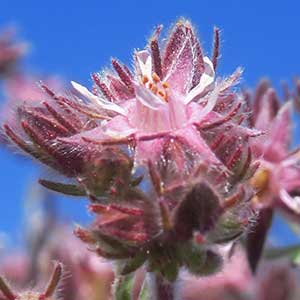Horkelia hendersonii
Horkelia sericata
Henderson's horkelia
Howell's horkelia, silky horkelia
ascending to erect, 0.8–2(–2.5) dm.
ascending to erect, 1.5–4.5 dm, hairs 1 mm proximally, glands absent or sparse distally.
3–8 × 0.7–1.5 cm;
leaflets (5 or)6–12 per side, overlapping at least distally, cuneate to flabellate, 4–9(–10) mm, divided 1/2+ to midrib into 3–6 oblanceolate to obovate lobes (often medially notched more than 3/4 to midrib as well), silky villous.
± cylindric to weakly planar, 3–10 × 0.3–1.2 cm, densely sericeous, often villous on margins apically;
stipules usually entire or forked, rarely pinnately divided into linear lobes;
leaflets (8–)10–20 per side, ± overlapping, elliptic to flabellate, 2–8 × 1–4 mm, 1/2–2/3 as wide as long, divided ± 1/2+ to midrib into (0–)2–4 elliptic lobes 1–2 mm wide, these not restricted to apex.
2–3.
(2 or)3–5;
stipules 3–8 mm, entire or shallowly 1–2-toothed.
open, flowers arranged individually and/or in non-capitate glomerules.
2–8(–10) mm.
1–4 mm.
(2–)4–15(–20), 10 mm diam.;
epicalyx bractlets linear, 2.5–4.5 × 0.2–0.5 mm, 2/3 to nearly equal to length of sepals;
hypanthium 1–2.5 × (2–)3–4(–5) mm, ± 1/2 as deep as wide, interior densely villous;
sepals spreading, narrowly lanceolate, 3.5–6 mm, silky hairs silky, 1–1.5 mm;
petals often pink-tinged, linear to narrowly oblanceolate, 2.5–5 × 1 mm, apex ± acute to narrowly rounded, sometimes slightly mucronate;
filaments pinkish, 2 × 0.5–0.7 mm, glabrous or sparsely pilose adaxially, anthers 0.5–0.7 mm;
carpels 8–17;
styles (1.5–)2–3 mm.
10 mm diam.;
epicalyx bractlets linear-lanceolate, 1.5–3 × 0.5 mm, ± 2/3 length of sepals;
hypanthium 1–1.5 × 2–3 mm, ± 1/2 to as deep as wide, interior glabrous;
sepals spreading to reflexed, abaxially green to reddish or purplish, 2–4 mm;
petals white to pink or red-veined, narrowly obcordate, 3–4.5(–7) × 2–3 mm, apex ± emarginate;
filaments 0.5–1.5 × 0.2–0.5 mm, anthers 0.4–0.6 mm;
carpels 2–6;
styles 1.5–2 mm.
dark brown, 2 mm.
brown, 2–2.5 mm, smooth.
= 28.
Horkelia hendersonii
Horkelia sericata
Of conservation concern.
Horkelia hendersonii is one of the more attractive species of the genus, with its grayish mats and dusky pink inflorescences. P. A. Rydberg (1898) placed it initially in his group Capitatae, here restricted to H. fusca, and later (1908c) transferred it to his new group Tenuilobae, which otherwise comprised only H. tenuiloba. The species is known only from Jackson County, Oregon, and an isolated population in adjacent Siskiyou County, California. The populations are vulnerable due to their proximity to popular recreational sites.
(Discussion copyrighted by Flora of North America; reprinted with permission.)
Of conservation concern.
D. D. Keck (1938) expanded the circumscription of Horkelia sericata to encompass the plants segregated here as H. howellii, on the grounds that intergradation is too extensive to justify taxonomic recognition of the extremes. In this evaluation, however, most collections can be unequivocally divided between plants with compact silvery-sericeous leaves with entire or forked stipules (H. sericata), and plants with larger, greener leaves and pinnately divided stipules (H. howellii). It is not known if the chromosome count provided by P. A. Munz (1959) was derived from H. howellii or H. sericata.
As here circumscribed, Horkelia sericata is a localized taxon known only from Curry County, Oregon, and the Gasquet serpentine area in adjacent Del Norte County, California.
(Discussion copyrighted by Flora of North America; reprinted with permission.)


